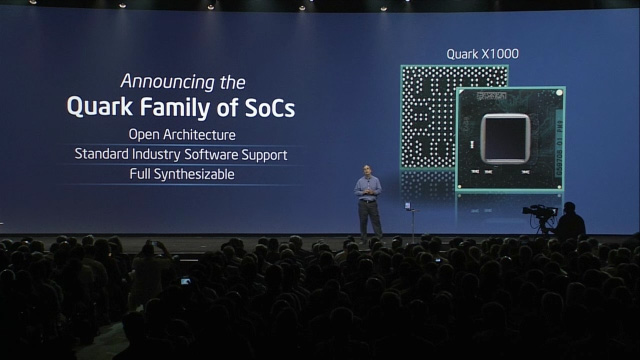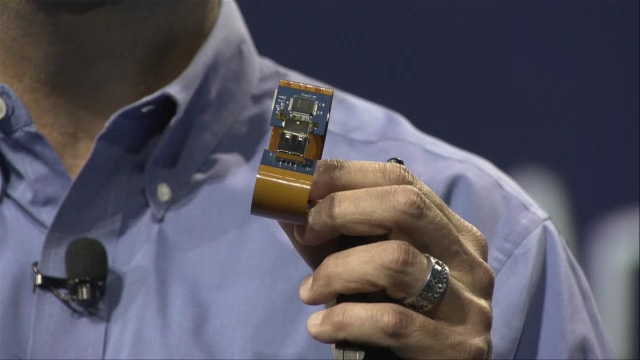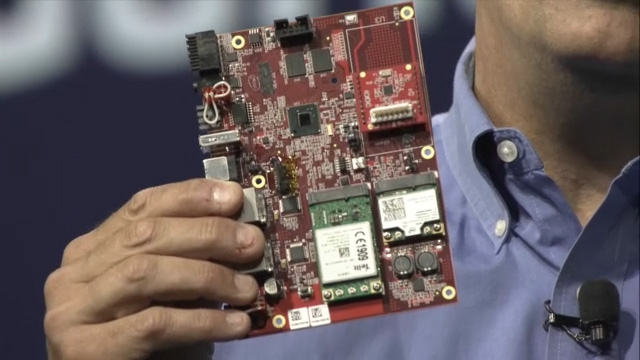Intel Announces “Quark” SoC Family: Tiny SoCs For Tiny Devices
by Ryan Smith on September 10, 2013 2:05 PM EST
Kicking off today is the 2013 Intel Developer Forum, Intel’s annual gathering of developers, press, and techies. Among the many sessions scheduled over the rest of the week we’re expecting several product announcements, and as is customary the first few of these announcements have been dropped in this morning’s opening keynote, being delivered by Intel’s new CEO, Brian Krzanich.
The first – and certainly hottest item – is the announcement of a new line of SoCs from Intel. Dubbed the Quark family, these SoCs will be slotted in below Intel’s existing and future Atom products, being designed with a strong emphasis on size and power consumption. Intel isn’t giving the press any hard numbers at this time, but they are throwing around the idea of one-fifth the size and one-tenth the size of their existing low-end Atom (Silvermont) CPU cores. Based on these statements a quick extrapolation in turn suggests that the die size of Quark is going to be under 10mm2 and targeting power consumption under 100mW, reinforcing just how small and low power Intel is going with these chips.
Update: Intel has sent over a quick clarification on size; the size comparisons are meant to be core-to-core rather than SoC-to-SoC. Specifically compared to the 22nm Silvermont core.

Being smaller, lower power, and less powerful than Atom, Intel will be chasing after the “internet of things” market with Quark products. With Atom covering tablets, smartphones, and similar devices, Intel is tasking Quark with covering the markets that traditionally use embedded microprocessors and other types of low power, low performance controllers. This would cover everything from wearable computers to smart watches on the consumer side, and any number of uses in industrial products as we already see today. Intel for their part isn’t going to be going into producing any such end user devices, but they are showing off some braclet-like devices as proof of concept reference designs at the show.
Looking at the specs and the use cases, although Intel doesn’t specifically name ARM as a competitor here, it’s clear that Intel is going after ARM’s other market segments to at least some extent with Quark. ARM’s Cortex M and Cortex R processor IP already competes in the spaces that Intel is naming for Quark, so there is some obvious overlap there. Furthermore ARM juggernaut Qualcomm has shown a clear interest in the “internet of things” concept and its potential to be the next explosive market, and have in turn been working on their own Cortex M based designs and sample products using them, such as the recently announced Toq smartwatch.

But perhaps the most interesting aspect of Quark is what hasn’t been said: architecture. Intel has not specifically named the architecture that Quark will be based on, which calls into question whether it will be based on x86 – like virtually all of Intel’s other microprocessors – or if they’re utilizing another architecture to meet the extreme size and power requirements of Quark. At the same time Intel is calling Quark an “open architecture” product, which is not a term they typically attach to x86. Hopefully we’ll be able to get Intel to talk more about the architecture once we hit the showfloor.
Update: Intel has confirmed to us that Quark's architecture is "Pentium ISA compatible", making it x86 for the purposes of the front-end.
Wrapping things up, alongside the announcement of Quark Intel has also briefly laid out their launch plans for the new SoC. As to be expected, Quark isn’t shipping yet. The first Quark product will be 32nm, with Intel sampling reference boards based on that SoC in the 4th quarter, followed by a full release occurring at a yet-to-be-announced point after that. For the initial wave of Quark products Intel will be playing it conservatively, targeting existing industrial microcontroller users such as energy, transportation, and other general industrial segments. These are the markets where Quark is closest to a drop-in replacement, while Intel’s more ambitious vision for consumer markets will take further time to develop as their partners continue to work out product designs and where such an SoC makes sense.

Source: Intel










26 Comments
View All Comments
SeleniumGlow - Tuesday, September 10, 2013 - link
I'll be amazed (or not?) if they drop in an ARM architecture in the Quark... or ARM like... they do have a license for it... time to use 'em I guess.DanNeely - Tuesday, September 10, 2013 - link
I thought they sold the license along with their previous arm cpu family.SeleniumGlow - Tuesday, September 10, 2013 - link
Yes... what you said is correct. Intel did sell it off to Marvell, however they did keep the license for ARM at architectural level (as in wikipedia... I know it isn't a good source, but that's all I have). Intel is keeping us in nice suspense here though.Jaybus - Tuesday, September 10, 2013 - link
Intel has been building RISC processors for a very long time, probably longer than ARM. Certainly the i960 was being designed around the time of the founding of Advanced RISC Machines, Ltd. They definitely have the ability to design an updated RISC core. Not to say that Quark is definitely RISC at all. My bet is that it's a 32-bit x86.bhtooefr - Tuesday, September 10, 2013 - link
Winner winner chicken dinner."As for the core Intel’s spokeswoman Caludia Mangano said that the first product in the Quark family is a synthesizable Pentium ISA compatible CPU core."
http://gigaom.com/2013/09/10/intel-announces-new-q...
jwcalla - Tuesday, September 10, 2013 - link
Jeez. They have a really weird definition of "open architecture".iMacmatician - Tuesday, September 10, 2013 - link
According to what was reported in the PCPer live blog, the core isn't open, but the fabric is.wlee15 - Tuesday, September 10, 2013 - link
Marvell already had a ARM architectural license when it bought Intel's ARM line plus I don't think the license is transferable.Penti - Tuesday, September 10, 2013 - link
Uhm, they build ARM-based baseband chips in the millions. So they do license low end ARM Ltd IP-cores already and they didn't need to transfer any license when they sold of the XScale series, they continued to produce EOL/legacy network processors and such for a while after the sale so it didn't immediately expire. Their SSD controllers also contains some form of ARM-core. Their chipset actually contains a ARC-core for management capabilities. Their WiFi, GPS solutions also contains microprocessors. Remember it was a long time ago Intel was a MCU company. Of course they will use ARM and others. Doing custom microcontrollers with custom architecture isn't their business though.jfinely - Tuesday, September 10, 2013 - link
Intel confirmed it is X86 compatible to the eetimes's Rick Merriteetimes.com/document.asp?itc=eetimes%5Fsitedefault&doc_id=1319447&page_number=1